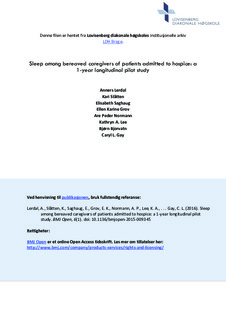| dc.contributor.author | Lerdal, Anners | |
| dc.contributor.author | Slåtten, Kari | |
| dc.contributor.author | Saghaug, Elisabeth | |
| dc.contributor.author | Grov, Ellen Karine | |
| dc.contributor.author | Normann, Are Peder | |
| dc.contributor.author | Lee, Kathryn A. | |
| dc.contributor.author | Bjorvatn, Bjørn | |
| dc.contributor.author | Gay, Caryl | |
| dc.date.accessioned | 2017-09-20T09:01:14Z | |
| dc.date.available | 2017-09-20T09:01:14Z | |
| dc.date.created | 2016-01-06T12:42:28Z | |
| dc.date.issued | 2016 | |
| dc.identifier.citation | BMJ Open. 2016, 6 (1), . | nb_NO |
| dc.identifier.issn | 2044-6055 | |
| dc.identifier.uri | http://hdl.handle.net/11250/2455713 | |
| dc.description.abstract | Abstract Objectives This pilot study aimed to describe the sleep of partners and other family caregivers prior to and in the first year after a hospice patient's death. The study also evaluated the feasibility of the study protocol and determined the effect sizes in preparation for a full-scale study. Design The pilot study used a longitudinal, descriptive and comparative design. Setting and participants Participants included primary family caregivers of patients admitted to a hospice in Oslo, Norway. Primary outcome Caregiver sleep was measured subjectively with the Pittsburgh Sleep Quality Index (PSQI) and objectively using wrist actigraphy for 4 nights and 3 days at three different times: during the hospice stay, and at 6 and 12 months after the patient's death. Results 16 family caregivers (10 partners and 6 other family members) completed the 1-year study protocol. Overall, sleep quality and quantity were stable over time and at each assessment, approximately half of the sample had poor sleep quality, both by self-report and objective measures. However, the sleep trajectories differed significantly over time, with older caregivers (≥65 years) having significantly longer sleep durations than younger caregivers (<65 years). Furthermore, sleep quality also differed over time depending on the caregiver's relationship to the patient, with partner caregivers having significantly worse sleep quality than other family caregivers. Conclusions Caring for a dying family member is known to interfere with sleep, yet little is known about bereaved caregivers. The results of this pilot study demonstrate the feasibility of the longitudinal study protocol and indicate that sleep problems are common for caregivers and continue into the bereavement period, particularly for partner caregivers. The caregiver's relationship to the patient may be an important factor to consider in future studies. | nb_NO |
| dc.language.iso | eng | nb_NO |
| dc.relation.uri | http://bmjopen.bmj.com/content/6/1/e009345.full?keytype=ref&ijkey=QHY0IHD5sCKm1rt | |
| dc.rights | Attribution-NonCommercial-NoDerivatives 4.0 Internasjonal | * |
| dc.rights.uri | https://creativecommons.org/licenses/by-nc-nd/4.0/ | * |
| dc.subject | Søvn | nb_NO |
| dc.subject | Familie | nb_NO |
| dc.title | Sleep among bereaved caregivers of patients admitted to hospice: a 1-year longitudinal pilot study | nb_NO |
| dc.type | Journal article | nb_NO |
| dc.type | Peer reviewed | nb_NO |
| dc.description.version | publishedVersion | nb_NO |
| dc.source.pagenumber | 9 | nb_NO |
| dc.source.volume | 6 | nb_NO |
| dc.source.journal | BMJ Open | nb_NO |
| dc.source.issue | 1 | nb_NO |
| dc.identifier.doi | 10.1136/bmjopen-2015-009345 | |
| dc.identifier.cristin | 1306976 | |
| cristin.unitcode | 1992,9,0,0 | |
| cristin.unitcode | 1992,0,0,0 | |
| cristin.unitname | Administrasjonen | |
| cristin.unitname | Lovisenberg Diakonale Sykehus | |
| cristin.ispublished | true | |
| cristin.fulltext | original | |
| cristin.qualitycode | 1 | |

